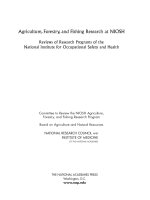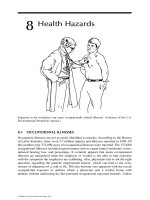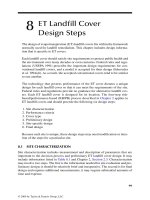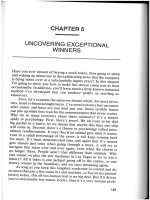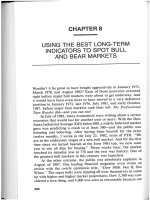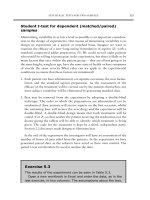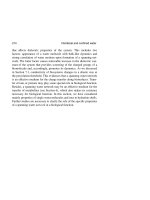DEFINITIONS CONVERSIONS and CALCULATIONS for OCCUPATIONAL SAFETY and HEALTH PROFESSIONALS - CHAPTER 8 pps
Bạn đang xem bản rút gọn của tài liệu. Xem và tải ngay bản đầy đủ của tài liệu tại đây (185.55 KB, 38 trang )
C
C
h
h
a
a
p
p
t
t
e
e
r
r
8
8
S
S
t
t
a
a
t
t
i
i
s
s
t
t
i
i
c
c
s
s
a
a
n
n
d
d
P
P
r
r
o
o
b
b
a
a
b
b
i
i
l
l
i
i
t
t
y
y
This chapter will discuss the broad areas of statistics and probability, as these disciplines
can be applied to the routine practice of occupational safety and health. Decision making
on matters of employee safety frequently involves the evaluation of statistical data, and
the subsequent development from these data of the probabilities of the occurrence of fu-
ture events. These evaluations and the subsequent projections are important because the
events being considered may involve workplace hazards. These two subjects: (1) the sta-
tistical aspects and (2) the probability considerations will be considered separately.
RELEVANT DEFINITIONS
Populations
A Population is any set of values of some variable measure of interest — for example, a
listing of the orthodontia bills of every person living on the island of Guam, or a tabulation
showing the count of the number of Letters to the Editor that were received by the Wash-
ington Post newspaper each day during 1996, would each make up a Population. A
Population is the entire set of those values, the entire family of objects, data, measure-
ments, events, etc. being considered from a statistical, probabilistic, or combinatorial per-
spective. A Population may consist of “events“ that are either random or deterministic.
For reference, a deterministic event is one that can be characterized as “cause-and-effect” re-
lated — i.e., when a person loses his grip on a baseball [the “cause”], the ball will fall to
the ground [the “effect” event that was deterministically produced in a totally predictable
manner by the identified “cause”]. Populations may also consist of “members” whose
values are themselves functions of a second, or a third, or even some higher number of ran-
dom variables. The two example Populations listed above are most likely random [and
therefore, not deterministic] — i.e., in each case, the values in either of these Popula-
tions are not obviously related to, or functions of, any other identifiable random factor or
variable.
Distributions
A Distribution is a special type or subset of a population. It is a population, the values
of whose “members” are related or a function of some identifiable and quantifiable random
variable. A Distribution is virtually always spoken of or characterized as being “a func-
tion of some random variable”; the most common mathematical way to represent such a
Distribution is to speak of it as a function of “x” — i.e., f(x), where “x” is the random
variable. Examples of Distributions might be the per acre yield of soybeans as a function
of such things as: (1) the amount of fertilizer applied to the crop, (2) the volume of irriga-
tion water used, (3) the average daytime temperature during the growing season, (4) the
acidity of the soil, etc. Any Distribution that is characterized as being an f(x), for “x”,
some continuous random variable, can be and is also frequently described as being:
(1) a Probability Density Function,
(2) a Probability Distribution,
(3) a Frequency Function, and/or
(4) a Frequency Distribution, etc.
© 1998 by CRC Press LLC.
Specific Types of Distributions
Uniform Distribution
A Uniform Distribution is one in which the value of every member is the same as the
value of every other member. An example of a Uniform Distribution would be the
situation where the Safety M anager of a manufacturing plant had to complete safety inspec-
tions of various production areas at random times during the 8-hour workday. If this work-
day is thought of as being divided up into 480 one-minute intervals, the probability of the
Safety Manager visiting during any one of these intervals will be equally likely. Clearly —
if the Safety Manager actually makes his visits on a random basis — each of these intervals
will be equally likely to be selected; thus the “value” for each of these intervals will be
equal [i.e., the probability of a visit during any specific interval will be 1/480, or 0.00208],
and the population of these values can be said to constitute a Uniform Distribution.
Normal Distribution
A Normal Distribution is one of the most familiar types in this overall category of
distributions — its applications apply to virtually any naturally occurring event. The
“graphical” representation of a Normal Distribution is the well-known and widely un-
derstood “bell-shaped curve”, or “normal probability distribution curve”. The Normal
Distribution is almost certainly the most important and widely used foundation block in
the science of statistical inference, which is the process of evaluating data for the purpose of
making predictions of future events. This type of distribution is always perfectly symmet-
rical about its Mean [described on Page 8-4]. Examples of Normal Distributions are:
(1) the number of tomatoes harvested during one growing season from each plant in a one-
acre field of this crop; (2) the annual rainfall at some specific location on the island of
Kauai, HI; (3) the magnitude of the errors that arise in the process of reading a dial oven
thermometer, etc.
Binomial Distribution
A Binomial Distribution is one in which every included event will have only two pos-
sible outcomes. It is a distribution made up of members whose values depend upon a bi-
nomial random variable. This category of variable can be most easily understood by consid-
ering one of its most familiar members, namely, the result of flipping a coin — a process
for which there are only two possible outcomes, “HEADS” and/or “TAILS” [here we as-
sume that the coin cannot land on and remain on its edge]. An example of a Binomial Dis-
tribution would be the genders of all the individuals standing in the Ticket Line for the
musical, Phantom of the Opera . Binomial Distributions in general, and particularly
those with a large number of members, can be considered and handled, for any necessary
computational effort, as Normal Distributions.
Exponential Distribution
An Exponential Distribution is frequently described as the Waiting Time Distribution,
since many populations in this category involve considerations of variable time intervals.
This class of distribution is relatively easy to understand by considering a couple of exam-
ples. A first might be the lengths of time between Magnitude 7.5+ earthquakes on the
San Andreas Fault in California. Another example might be the distances traveled by a
municipal bus between major mechanical breakdowns, etc. Both of these populations
would be characterized as Exponential Distributions.
© 1998 by CRC Press LLC.
Characteristics of Populations and/or Distributions
Member
A Member of any population or distribution is simply one item from the set that makes
up the whole. The Member can be any quantifiable characteristic — i.e., the height of any
individual who belongs to some social group; the number of shrimp caught each day by any
member of the Freeport, TX, fishing fleet; the number of times that the dice total 12 in a
game of Craps, etc.
Variable
A Variable is a characteristic or property of any individual member of a population or
distribution. The name, “Variable”, derives from the fact that any particular characteristic
of interest may assume different values among the individual members of the population or
distribution being considered. If one was considering the distribution of the weights of ele-
phant calves born in captivity throughout the world, one might evaluate such data from a
variety of different random perspectives, or from the relationship of these birth weights to a
variety of Variables. Among such Variables might be: (1) the country in which the
birth occurred, (2) whether or not the birth occurred in a zoo, (3) a situation where the calf
was the offspring of a “work elephant”, or (4) the age of the mother elephant, etc.
Sample
A Sample is a subset of the members of an entire population. Samples, per se, are em-
ployed whenever one must evaluate some measurable characteristic of the members of an
entire population in a situation where it is simply not feasible to consider or measure every
member of that population. For example, one might have to answer a question of the fol-
lowing type:
1. Does the average digital clock produced in a clock factory actually keep correct time? or
2. Is the butterfat content of the daily output of homogenized milk from a dairy at or above
an established standard for this factor?
In order to make any of these types of determinations, it is not usually considered necessary
to sample and test every member of the population — rather such a determination can usu-
ally be made by obtaining and testing a Sample from the population of interest. For the
two questions asked above, one might sample and test one of every 10 clocks, or one of
every 1,000 gallons of milk, etc.
Parameter
A Parameter is a calculated quantitative measure that provides a useful description or
characterization of a population or distribution of interest. Parameters are calculated di-
rectly from observations, the summary tabulation of which make up the population or dis-
tribution being considered. For any population or distribution of interest, an example of a
Parameter would be that population’s or distribution’s Mean or Median [i.e., see Page 8-4
for complete descriptions of these terms].
Sample Statistic
A Sample Statistic is a specific numeric descriptive measure of a sample. It is calcu-
lated directly from observations made on the sample itself. Basically, a Sample Statistic
is a parameter that is determined for a sample — i.e., the sample standard deviation [see Page
8-5 for a compl ete descr iption of this term] . It is very commo n for a measu red Sampl e
© 1998 by CRC Press LLC.
Statistic to be thought of as representative of or applicable to the entire population or
distribution of interest.
Parameters of Populations and/or Distributions
Frequency Distribution
A Frequency Distribution is a tabulation of any of variable characteristics of any popu-
lation that can be measured, counted, tabulated, or correlated. For example, from the Fre-
quency Distribution that represents the results of the performance of high school seniors
on the Scholastic Aptitude Test, it can be predicted that a score of 1,290 will place the stu-
dent in the top 5% of all similar students taking this test.
Range
The Range of any set of variable data — taken from some population or distribution of
interest — will be the calculated result that is obtained when the value of the numerically
smallest member of the set is subtracted from the value of the numerically largest member
of that same set — see Equation #8-1, from Page 8-10.
Mean
The Mean of any set of variable data — from some population or distribution of interest —
is the sum of the individual values of the items of that data set, divided by the total number
of items that make up the set. The Mean is the average value for the set of data being con-
sidered, and, in fact, the word “Average” is almost always used synonymously with Mean.
The Mean is the first important measure of the “central tendency” of that set of variables —
see Equation #8-3, from Page 8-11.
Geometric Mean
The Geometric Mean is a common alternative measure of the “central tendency” of any
set of variable data — from some population or distribution of interest. It is a somewhat
more useful measure than the simple Mean for any situation where the population or distri-
bution being evaluated has a very large range of values among its members — i.e., a range
of values varying over several orders of magnitude. Specifically, for any set of data, for
which the ratio R 200≥ or log R ≥ 2.30 — where R is defined as follows:
R=
the numeric value of the largest member of a population or distribution of interest
the numeric value of the smallest member of a population or distribution of interest
—
the Geometric Mean may be a better measure of this population’s or distribution’s central
tendency — See Equation #8-4, from Pages 8-11 & 8-12.
Median
The Median of any set of variable data — taken from some population or distribution of
interest — is the middlemost value of that data set. When all the individual variable mem-
bers of the set have been arranged either in ascending or descending order, the Median will
be either:
(1) the data point that is exactly in the center position, or
(2) if there are a number of same value data points at, near, or around the center position,
then this parameter will be the value of the data point that is centermost.
© 1998 by CRC Press LLC.
It can be regarded as the "Midpoint" value in any Normal Distribution containing "n" differ-
ent numeric values, x
i
. For such a set, it is that specific value of x
n2
, for which there are
as many values in the distribution greater than this number, as there are values in the distri-
bution less than this number. It is the second important measure of the “central tendency”
of the set of variables being considered — see Equation #8-5, from Pages 8-12 & 8-13.
Mode
The Mode of any set of variable data points — taken from some population or distribution
of interest — is the value of the most frequently occurring member of that set. The Mode
is the "most populous" value in any Normal Distribution containing “n” different numeric
values, x
i
. For such a set, it is that specific x
i
which is the most frequently occurring value
in the entire distribution. The Mode is the third most important measure of the “central
tendency” of the set of variables being considered; however, it does not have to be a value
that is close to the center of that population. It can be numerically the smallest, or the
largest, or any other value in the set, so long as it appears more frequently than any other
value — see Equation #8-6, from Page 8-13.
Sample Variance
The Sample Variance of any set of “n” data points — taken from some population or
distribution of interest — is equal to the sum of the squared distances of each member of
that set from the set's Mean. This squared “distance” must then be divided by one less than
“n”, the number of members of that set — i.e., the denominator in this process is the quan-
tity, “(n – 1)” — see Equation #8-7, from Pages 8-13 & 8-14.
This parameter looks at the absolute “distance” between each value in the set and the value
of the set’s Mean. If one were simply to obtain a simple “average” of these distances, the
result would be zero, since some of these values would be negative, while a compensating
number would be positive. To correct for this in the computation of the Sample Vari-
ance, each of these “distances” is squared; thus the result for each of these operations will
always be positive, and a measure of the absolute “value-to-mean distance” will thereby be
obtained.
The Sample Variance is always designated by the term, “s
2
”, and its dimensions will
always be the square of the dimensions of the values of the members of the population or
distribution being considered — i.e., if the population is a set of values measured in U.S.
Dollars, then s
2
will be in units of [U.S. Dollars]
2
.
For a Normal Distribution, the Sample Variance will probably be the best and least
biased [i.e., the most unbiased] estimator of the true Population Variance.
Sample Standard Deviation
The Sample Standard Deviation of any set of variable data points — taken from some
population or distribution of interest — is equal to the positive square root of the Sample
Variance, as defined above on this page. For the relationship that defines this parameter, see
Equation #8-9, on Pages 8-14 & 8-15.
The Sample Standard Deviation is always designated by the term, “s”, and its dimen-
sions will always be the same as the dimensions of each member in the population or dis-
tribution being considered — i.e., if the population is a set of values measured in U.S. Dol-
lars, then “s” [unlike the Sample Variance, “s
2
”, of which “s” is the square root] will also be
in units of U.S. Dollars.
© 1998 by CRC Press LLC.
For a Normal Distribution, the Sample Standard Deviation will be a better, less bi-
ased estimator of the true and most useful Population Standard Deviation.
Sample Coefficient of Variation
The Sample Coefficient of Variation is simply the ratio of the Sample Standard
Deviation to the Mean of or for the population or distribution being considered — see Equa-
tion #8-11, from Pages 8-15 & 8-16. This parameter is also commonly described as the
Relative Standard Deviation.
For any Normal Distribution, the Sample Coefficient of Variation is thought to be
a good to very good measure of the specific dispersion of the values that make up the set
being examined. This coefficient is most commonly designated as “CV
sample
”, and it is a
dimensionless number. Since the Sample Coefficient of Variation is regarded as a
less biased, and therefore better estimator of the dispersion that characterizes the data in the
distribution being considered, and does so more effectively than does its more biased coun-
terpart, the Population Coefficient of Variation, this parameter tends to be the much more
widely used of the two.
Population Variance
The Population Variance of any set of “n” data points — taken from some population
or distribution of interest — is equal to the average of the squared distances of each member
of that set from the Mean of the set — see Equation #8-8, from Page 8-14.
This parameter, like its Sample Variance counterpart, also looks at the absolute “distance”
between each value in the set and the value of the set’s Mean. Again, if one were simply to
obtain a simple “average” of these distances, the summation result would always be zero,
since roughly half of these distances are negative, while the remainder are positive. To cor-
rect for this in this computation and thereby obtain a true measure of the absolute distance,
each of these “distances” is squared; thus the result will always be a positive number, and a
very effective measure of the absolute “value-to-mean distance” will thereby be obtained.
The Population Variance is always designated by the term, “σ
2
”, and its dimensions
will always be the square of the dimensions of each member in the population being consid-
ered — i.e., if the population is a set of values measured in units of “lost time inju-
ries/1,000 work days”, then σ
2
will be in units of [lost time injuries/1,000 work days]
2
.
For a Normal Distribution, the Population Variance will usually be slightly more bi-
ased in determining a useful and precise value for this parameter than will its Sample Vari-
ance counterpart, and for this reason, it is used less frequently than the Sample Variance.
Population Standard Deviation
The Population Standard Deviation of any set of variable data points — taken from
some population or distribution of interest — is equal to the positive square root of the
Population Variance, as defined above — see Equation #8-10, from Page 8-15, for the
mathematical relationship for the Population Standard Deviation.
The Population Standard Deviation is always designated by the term, “σ”, and its
dimensions will always be the same as the dimensions of each value in the population be-
ing considered — i.e., if the population is a set of values measured in “lost time inju-
ries/1,000 work days”, then “σ” [unlike the Population Variance, of which “σ” is the square
root] will also be in units of “lost time injuries/1,000 work days”.
© 1998 by CRC Press LLC.
For a Normal Distribution, the Population Standard Deviation will be slightly more
biased as an estimator; thus, it is used less frequently in these determinations than the Sam-
ple Standard Deviation.
Population Coefficient of Variation
The Population Coefficient of Variation is simply the ratio of the Population
Standard Deviation to the Mean of or for the population or distribution being considered —
see Equation #8-12, from Page 8-16.
For any Normal Distribution, the Population Coefficient of Variation is thought to
be a slightly biased measure of the specific dispersion of the values that make up the set
being examined. This coefficient is most commonly designated as “CV
population
”, and it is a
dimensionless number. Since the Population Coefficient of Variation is regarded
as a slightly more biased, and therefore poorer estimator of the dispersion that characterizes
the data in the distribution being considered, its counterpart, the Sample Coefficient of
Variation, tends to be much more widely used.
Probability Factors and Terms
Experiment
An Experiment is a procedure or activity that will ultimately lead to some identifiable
outcome that cannot be predicted with certainty. A good example of an Experiment
might be the result of throwing a fair die and observing the number of dots that appear on
the up-face. There are six possible result outcomes for such an Experiment; in order they
are: one dot, two dots, three dots, four dots, five dots, and six dots. Each of these outcomes
is equally likely; however, the specific result of any single Experiment can never be pre-
dicted with certainty.
Result
A Result is the most basic and simple outcome of any Experiment — i.e., for the Ex-
periment of throwing of a fair die, there are a total of six possible Results, as described
above.
Sample Space
The Sample Space of any Experiment is the totality of all the possible Results of that
Experiment. For the Experiment of throwing a fair die described above, the Sample
Space would be: one, two, three, four, five, and six. This Sample Space is most fre-
quently represented symbolically in the following way:
S: {1, 2, 3, 4, 5, 6}
Event
An Event is a sub-set of specific Results from some well-defined overall Sample Space —
i.e., for the fair die throwing Experiment described above, a specific Event might be the
occurrence of an even number on the up-face of the die. From the totality of the Sample
Space for this Experiment, the even number on the up-face of the die Event would be the
following sub-set: two, four, and six — or listing this Event as a sort of Sub-Sample
Space, the following would be its symbolic representation:
S
even
: {2, 4, 6}
© 1998 by CRC Press LLC.
Compound Event
A Compound Event is some useful or meaningful combination of two or more different
Events. Compound Events are structured in two very specific ways. In order, these struc-
tures are shown below:
1. The UNION of two Events — say, M & N — is the first type of a Compound
Event. A UNION is said to have taken place whenever either M or N, or both M &
N occur as the outcome of a single execution of the Experiment. Symbolically, a
UNION, as the first category of a Compound Event, is represented in the follow-
ing way — again assume we are dealing with the two Events, M & N:
M NU
Considering again the Experiment of throwing a fair die and observing its up-face, we
might have an interest in the following two events: (1) M = the Result is an even
number, and (2) N = the Result is a number greater than three. The Sub-Sample
Space that makes up the UNION of these two Events would be:
S
MNU
: {2, 4, 5, 6}
2. The INTERSECTION of two Events — again, say, M & N — is the second type of
Compound Event. An INTERSECTION is said to have taken place whenever both
M & N occur as the outcome of a single execution of the Experiment. Symbolically,
an INTERSECTION, as the second category of a Compound Event, is represented in
the following way — again assume we are dealing with the two Events, M & N:
M NI
Considering again the die throwing Experiment, and the same two events described
above in the section on the UNION, the Sub-Sample Space that makes up the IN-
TERSECTION of these two events would be:
S
MNI
: {4, 6}
Complementary Event
A Complementary Event is the totality of all the alternatives to some specific Event of
interest. Within any Sample Space, the Complement to some Event of interest — say,
M — will be every other possible Result that is not included within M. That is to say,
whenever M has not occurred, its Complement — designated symbolically as M' — will
have occurred.
Considering again the Experiment of throwing a fair die and observing its resultant up-face,
we might have an interest in the event: M = the Result is an even number. For this event,
its Complement, M' = the Result, is an odd number. The Sub-Sample Spaces for the
Event, M, would be shown symbolically as:
S
M
: {2, 4, 6}
The Sub-Sample Space for the Complement to M, again designated as M' , would be:
S
M’
: {1, 3, 5}
Probabilities Associated with Results
The Probability of the Occurrence of a Result must always lie between 0 and
100% [or as a decimal, between 0.00 and 1.00]. This probability is a measure of the rela-
tive frequency of occurrence of the Result of interest. It is the outcome frequency that
would be expected to occur if the Experiment were repeated over and over and over — i.e., a
very large number of repetitions.
© 1998 by CRC Press LLC.
For example, in the Experiment of throwing and observing the up-face of a fair die, the
probability of observing a “two” would be 1/6. This 1/6 factor would also be the probabil-
ity associated with each one of the other five Results that exist within this Experiment’s
Sample Space.
It is important to note in this context that the probabilities of all the Results within any
Sample Space must always equal 100%, or 1.00.
Probability of the Occurrence of Any Type of Event
The Probability of the Occurrence of any Type of Event can be determined by
following the following five-step process:
1. Define as completely as possible the Experiment — i.e., describe the process in-
volved, the methodology of making observations, the way these observations will be
documented, etc.
2. Identify and list all the possible individual experimental Results.
3. Assign a probability of occurrence to each of these Results.
4. Identify and document the specific Results that will make up or are contained in the
Event, the Compound Event, or the Complementary Event of interest.
5. Sum up the Result probabilities to obtain the Probability of the Occurrence
of the Event, the Compound Event, or the Complementary Event of inter-
est.
© 1998 by CRC Press LLC.
RELEVANT FORMULAE & RELATIONSHIPS
Parameters Relating to Any Population or Distribution
Equation #8-1:
The following Equation, #8-1, defines the Range for any data set, population, or distribu-
tion of interest. It is determined by subtracting the Value of the Numerically
Smallest Member of the set from the Value of the Numerically Largest Mem-
ber.
R = x – x
ii
maximum minimum
[]
Where: R = the Range of the data set, population, or
distribution consisting of “n" different
members designated as “x
i
”;
x
i
= any of the “n” members of the data set,
population, or distribution being consid-
ered;
i
maximum
= the subscript index of the numerically larg-
est member of the data set, population, or
distribution being considered — indicating
in Equation #8-1 the numerically largest
member of the set by the term: x
i
maximum
; &
i
minimum
= the subscript index of the numerically larg-
est member of the data set, population, or
distribution being considered — indicating
in Equation #8-1 the numerically smallest
member of the set by the term: x
i
minimum
.
Equation #8-2:
The relationship that is used to characterize the relative magnitude of the range for any data
set, distribution, or population under consideration is given by Equation #8-2. This ex-
pression is simply the ratio of the numerically largest member of any data set to its small-
est member. This ratio is used to characterize the magnitude of the range for any distribu-
tion, population, or data set. Whenever a distribution, population, or data produces a value
for R that is greater than 200, that distribution, population, or data set is said to have a
relatively large range.
R
x
i
=
x
i
maximum
minimum
Where: R = the ratio of the largest member of any dis-
tribution or population to the smallest
member of the same distribution or popula-
tion;
© 1998 by CRC Press LLC.
x
i
maximum
= is the Value of the largest member of the
distribution or population under considera-
tion; &
x
i
minimum
= is the Value of the smallest member of the
distribution or population under considera-
tion.
Equation #8-3:
The following Equation, #8-3, defines the first, and the most important and, almost cer-
tainly the most widely used measure of location — or “central tendency” — for any type of
population, distribution, or data set. This measure has been identified under a variety of
names, among which are: Mean, Average, Arithmetic Mean, Arithmetic Average, etc. For
the purpose of discussion in this text from this point forward, this parameter will always be
identified as the Mean. In general, the Mean is designated either by the Greek letter, “µ”,
or by “
x
”.
µ ==
∑
=
x
n
x
i
i
n
1
1
Where: µ =
x
= the Mean of the population, distribution,
or data set of “n" different values of x
i
—
the dimensions of the Mean and the indi-
vidual members in the population, distribu-
tion, or data set will always be identical;
x
i
= the value of the “ith” member of the total
of “n” members in the overall population,
distribution, or data set;
n = the number of members in the overall
population, distribution, or data set being
considered; &
i = the “index” of the population, distribution,
or data set being considered, this term will
always appear as a subscript on the term
representing a variable member of the over-
all population, distribution, or data set; this
index will identify the position of the
subscripted member within the overall
population, distribution, or data set.
Equation #8-4:
The following Equation, #8-4, characterizes and defines a second measure of location — or
“central tendency” — for any measurable or quantifiable parameter, for any distribution
(normal or otherwise). This measure is called the Geometric Mean of the distribution.
It is somewhat more useful than the simple Mean — at least as a measure of this “central
tendency” — whenever the distribution being examined or analyzed has a very large range,
© 1998 by CRC Press LLC.
which might be defined as one with values varying over several orders of magnitude [i.e., a
range for which R
≥
200, or logR
≥
2.30 — see Equation #8-2, on Pages 8-10 & 8-11].
Whenever a distribution has such a large range, the Geometric Mean will probably be a
better indicator of its “central tendency” than will the simple Mean. It must be noted, how-
ever, that one can determine a Geometric Mean value for any distribution, population, or
data set regardless of the magnitude of its range.
The relationships that are used to calculate this parameter are given below in two forms: the
first is simply the direct mathematical relationship representing the definition of the Geo-
metric Mean, while the second is presented in a format that will probably prove to be
slightly easier to use in any case where the value of this parameter must be determined —
particularly, for any distribution that has a relatively large to very large range.
Mxxx
geometric n
n
= x . . . x
1n–1
()()
()
()()
23
M
geometric
x
i
i
n
= 10
1
n
log
=
∑
1
Where: M
geometric
= the Geometric Mean of the distribution,
population, or data set under consideration;
x
i
= is the value of the “ith” of “n” members of
the overall distribution, population, or data
set under consideration;
n = the number of members in the distribution,
population, or data set under consideration.
Equation #8-5:
The following Equation, #8-5, is actually more of a definition. It characterizes the third
measure of location, or “central tendency”, for any quantifiable parameter, preferably for the
situation in which the information being analyzed makes up a normal distribution. This
parameter is called the Median. Although it is considered to be most applicable to normal
distributions, a Median value can be determined for any other type of distribution, popula-
tion, or data set.
M
e
= the Median or "midpoint" value [principally for a normal distribution]
of "n" different numeric values of “x
i
” — i.e., when all the members of
the distribution, population, or data set have been arranged in an increas-
ing or a decreasing order by their numeric values, the Median will be in
the middle position of the resultant ordered set. If “n” is odd, then the
Median will be the actual middle number in the data set. If “n” is
even, then the Median will be the numeric average , or mean , of the two
members of the ordered data set that jointly occupy the middle position
of that set.
Where: M
e
= the Median of the distribution, population, or data
set consisting of “n" different values of x
i
;
© 1998 by CRC Press LLC.
x
i
= is the value of the “ith” of “n” members of
the overall distribution, population, or data
set under consideration;
n = the number of members in the overall dis-
tribution, population, or data set under con-
sideration.
Equation #8-6:
The following Equation, #8-6, is also more of a definition. It characterizes the fourth
measure of location, or “central tendency”, for any quantifiable parameter, again preferably
for a situation in which the resultant distribution is normal. This parameter is called the
Mode. Although it is considered to apply most effectively to normal distributions, the
Mode can also be determined for any other type of distribution, population, or data set.
M
o
= the Mode or "most populous" value in any distribution, population, or data
set consisting of “n" different numeric values of “x
i
”, i.e., that specific nu-
meric value of “x
i
” which is the most frequently occurring value in the entire
distribution, population, or data set. Although the Mode is considered to be
an important measure of location or “central tendency”, this value can occur at
any position in the data set — i.e., it could be the smallest value, or the larg-
est, or any other value. In a normal distribution, the Mode will usually be
fairly close in value to the Median, and therefore, this parameter will provide
its most useful information when applied to this important class of distribu-
tion.
Where: M
o
= the Mode of the distribution, population,
or data set of “n" different Values of “x
i
”;
x
i
= is the value of the “ith” of “n” members of
the overall distribution, population, or data
set under consideration;
n = the number of members in the overall dis-
tribution, population, or data set under con-
sideration.
© 1998 by CRC Press LLC.
Equation #8-7:
The following Equation, #8-7 is shown in two equivalent forms, and defines the Sample
Variance, which is the first and most widely used measure of variability, or dispersion, of
the data in any distribution, population, or data set of interest.
s
n
x
n
i
n
i
n
2
22
11
=
x –
– 1
=
x –
– 1
ii
µ
[]
∑
[]
∑
==
Where: s
2
= the Sample Variance for the entire dis-
tribution, population, or data set of “n" dif-
ferent values of “x
i
”;
x
i
= is the value of the “ith” of “n” members of
the overall distribution, population, or data
set under consideration;
n = the number of members in the overall dis-
tribution, population, or data set under con-
sideration; &
µ =
x
= the Mean of the distribution, population, or
data set.
Equation #8-8:
The following Equation, #8-8, is shown in two equivalent forms, and defines the Popula-
tion Variance, which is the second measure of variability, or dispersion, of the data in
any distribution, population, or data set of interest.
σ
2
22
11
=
x –
=
x –
ii
µ
[]
∑
[]
∑
==i
n
i
n
n
x
n
Where: σσ
σσ
2
= the Population Variance for the entire
distribution, population, or data set of “n"
different values of “x
i
”;
x
i
= is the value of the “ith” of “n” members of
the overall distribution, population, or data
set under consideration;
n = the number of members in the overall dis-
tribution, population, or data set under con-
sideration; &
µ =
x
= the Mean of the distribution, population, or
data set.
Equation #8-9:
The following Equation, #8-9, which like its two predecessors is shown in two equivalent
forms, defines the Sample Standard Deviation, which is the third — and probably
most important — measure of variability, or dispersion, of the data in any distribution,
population, or data set of interest. In general, the Sample Standard Deviation is be-
© 1998 by CRC Press LLC.
lieved to be most applicable to normal distributions; however it can be and is applied to any
type of data set.
s
x
n
i
n
i
n
= s =
x –
n 1
=
x –
2
ii
µ
[]
∑
−
[]
∑
−
==
22
11
1
Where: s = the Sample Standard Deviation for
the entire distribution, population, or data
set of “n" different values of “x
i
”;
s
2
= the Sample Variance for the entire dis-
tribution, population, or data set of “n" dif-
ferent values of “x
i
”;
x
i
= is the value of the “ith” of “n” members of
the overall distribution, population, or data
set under consideration;
n = the number of members in the overall dis-
tribution, population, or data set under con-
sideration; &
µ =
x
= the Mean of the distribution, population, or
data set.
Equation #8-10:
The following Equation, #8-10, which like its three predecessors is shown in two equiva-
lent forms, defines the Population Standard Deviation, which is the fourth measure
of variability, or dispersion, of the data in any distribution, population, or data set of inter-
est. In general, the Population Standard Deviation is believed to be the least impor-
tant of the variability or dispersion quantifying parameters.
σσ = =
x –
=
x –
ii
2
22
11
µ
[]
∑
[]
∑
==i
n
i
n
n
x
n
Where: σσ
σσ
= the Population Standard Deviation
for the entire distribution, population, or
data set of “n" different values of “x
i
”;
σσ
σσ
2
= the Population Variance for the entire
distribution, population, or data set of “n"
different values of “x
i
”;
x
i
= is the value of the “ith” of “n” members of
the overall distribution, population, or data
set under consideration;
n = the number of members in the overall dis-
tribution, population, or data set under con-
sideration; &
µ =
x
= the Mean of the distribution, population, or
data set.
© 1998 by CRC Press LLC.
Equation #8-11:
The following Equation, #8-11, defines the Sample Coefficient of Variation or
Relative Standard Deviation, which is the first measure of the specific dispersion of
all the data in any population, distribution, or data set being considered. This expression is
shown in two identical forms below:
CV
sample
=
s
=
s
xµ
Where: CV
sample
= the Sample Coefficient of Variation
for any population, distribution, or data set
of “n" different values of “x
i
”;
s = the Sample Standard Deviation for the en-
tire distribution, population, or data set of
“n" different values of “x
i
”; &
µ =
x
= the Mean of the distribution, population, or
data set.
Equation #8-12:
The following Equation, #8-12, defines the Population Coefficient of Variation,
which is the second measure of the specific dispersion of all the data in any population,
distribution, or data set being considered. Proceeding logically from the previous relation-
ship — i.e., Equation #8-11 — this one has been provided below in two useful formats:
CV
population
= =
x
σ
µ
σ
Where: CV
population
= the Population Coefficient of Varia-
tion for the population, distribution, or
data set of “n" different values of “x
i
”;
σσ
σσ
= the Population Standard Deviation for the
entire distribution, population, or data set
of “n" different values of “x
i
”;
µ =
x
= the Mean of the distribution, population, or
data set.
© 1998 by CRC Press LLC.
STATISTICS & PROBABILITY PROBLEM SET
Data Set for Problem #s 8.1 through 8.11:
The following data set lists — for a large metal foundry — the “Workdays Without a Lost-
Time Accident” experience — i.e., the WDWLTA experience — for each of this com-
pany’s fifteen different functional departments. Every previous analysis of this foundry’s
Lost-Time Accident information has produced data that were normally distributed; you may,
therefore, assume that the data below also will be normally distributed.
Although it is not a specific requirement of any part of the several problems that have been
developed for this data set, a space has been provided to be used for the retabulation of the
data provided below. A retabulation in an ordered sequence, plus calculations of the three
derived values [also listed below], should greatly facilitate the determination of the answers
that have been requested in the eleven problem statements that are based on this data set.
Dept. # WDWLTA Dept. # WDWLTA Dept. # WDWLTA
1 85 2 71 3 102
4 43 5 90 6 87
7 55 8 118 9 63
10 62 11 77 12 62
13 95 14 82 15 69
The following space has been provided for the data retabulation to which reference was made
above.
12345
Dept. # x
i
= WDWLTA log x
i
x
i
– µ [x
i
– µ]
2
Column Summations
—— ——
© 1998 by CRC Press LLC.
Problem #8.1:
What is the Range of these data?
Applicable Definitions: Normal Distribution Page 8-2
Range Page 8-4
Applicable Formula: Equation #8-1 Page 8-10
Solution to this Problem: Page 8-30
Problem Workspace
Problem #8.2:
What is the Mean of these data?
Applicable Definitions: Normal Distribution Page 8-2
Mean Page 8-4
Applicable Formula: Equation #8-3 Page 8-11
Solution to this Problem: Page 8-30
Problem Workspace
© 1998 by CRC Press LLC.
Problem #8.3:
What is the Geometric Mean of these data?
Applicable Definitions: Normal Distribution Page 8-2
Geometric Mean Page 8-4
Applicable Formula: Equation #8-2 Pages 8-10 & 8-11
Equation #8-4 Pages 8-11 & 8-12
Solution to this Problem: Pages 8-30 & 8-31
Problem Workspace
Problem #8.4:
What is the Median of these data?
Applicable Definitions: Normal Distribution Page 8-2
Median Pages 8-4 & 8-5
Applicable Formula: Equation #8-5 Pages 8-12 & 8-13
Solution to this Problem: Page 8-31
Problem Workspace
© 1998 by CRC Press LLC.
Problem #8.5:
What is the Mode of these data?
Applicable Definitions: Normal Distribution Page 8-2
Mode Page 8-5
Applicable Formula: Equation #8-6 Page 8-13
Solution to this Problem: Page 8-31
Problem Workspace
Problem #8.6:
What is the Sample Variance for these data?
Applicable Definitions: Normal Distribution Page 8-2
Sample Variance Page 8-5
Applicable Formula: Equation #8-7 Pages 8-13 & 8-14
Solution to this Problem: Pages 8-31 & 8-32
Problem Workspace
© 1998 by CRC Press LLC.
Problem #8.7:
What is the Sample Standard Deviation for these data?
Applicable Definitions: Normal Distribution Page 8-2
Sample Standard Deviation Page 8-5
Applicable Formula: Equation #8-9 Pages 8-14 & 8-15
Solution to this Problem: Page 8-32
Problem Workspace
Problem #8.8:
What is the Sample Coefficient of Variation for these data?
Applicable Definitions: Normal Distribution Page 8-2
Sample Coefficient of Variation Page 8-6
Applicable Formula: Equation #8-11 Pages 8-15 & 8-16
Solution to this Problem: Page 8-32
Problem Workspace
© 1998 by CRC Press LLC.
Problem #8.9:
What is the Population Variance for these data?
Applicable Definitions: Normal Distribution Page 8-2
Population Variance Page 8-6
Applicable Formula: Equation #8-8 Page 8-14
Solution to this Problem: Pages 8-32 & 8-33
Problem Workspace
Problem #8.10:
What is the Population Standard Deviation for these data?
Applicable Definitions: Normal Distribution Page 8-2
Population Standard Deviation Page 8-6
Applicable Formula: Equation #8-10 Page 8-15
Solution to this Problem: Page 8-33
Problem Workspace
© 1998 by CRC Press LLC.
Problem #8.11:
What is the Population Coefficient of Variation for these data?
Applicable Definitions: Normal Distribution Page 8-2
Population Coefficient of Variation Page 8-7
Applicable Formula: Equation #8-12 Page 8-16
Solution to this Problem: Page 8-33
Problem Workspace
Data Set for Problem #s 8.12 through 8.17:
A petrochemical company has a total of 1,784 refinery employees at its refinery location in
a large gulf coast city. This company’s employee rolls at this location can be characterized
according to: (1) the age; (2) the gender; and (3) the compensation category of each em-
ployee, according to the following listing:
Hourly Employees
——————— < 25 years 25 to 34 years 35 to 44 years > 44 years
Male 56 259 309 191
Female 48 206 341 168
Salaried Employees
——————— < 25 years 25 to 34 years 35 to 44 years > 44 years
Male8 312942
Female 5 43 29 19
The company has decided that all of these employees must “attend” a 1-hour duration, inter-
active, computer-based, safety orientation program. To implement this program, the com-
pany will have available a total of 10 computer terminals. Every one of the company’s
1,784 employees will be required to complete this course. A maximum of 60 employees
can complete this training on any one day — made up of 6 sessions of 10 employees each.
The employees who will be involved in this safety orientation program will be selected
randomly, and no more than two salaried employees will ever be permitted to be simultane-
ously involved in any one 10-person session of this course.
© 1998 by CRC Press LLC.
Problem #8.12:
What is the probability that the very first person selected for the very first 10-person session
of this course will be female?
Applicable Definitions: Experiment Page 8-7
Result Page 8-7
Sample Space Page 8-7
Event Page 8-7
Probabilities Associated with Results Pages 8-8 & 8-9
Probabilities Associated with Events Page 8-9
Solution to this Problem: Pages 8-33 & 8-34
Problem Workspace
Problem #8.13:
What is the probability that the very first person selected for the very first 10-person session
of this course will be a salaried female?
Applicable Definitions: Experiment Page 8-7
Result Page 8-7
Sample Space Page 8-7
Event Page 8-7
Probabilities Associated with Results Pages 8-8 & 8-9
Probabilities Associated with Events Page 8-9
Solution to this Problem: Page 8-34
Problem Workspace
© 1998 by CRC Press LLC.
Problem #8.14:
What is the probability that the very first person selected for the very first 10-person session
of this course will be male and over 35 years of age?
Applicable Definitions: Experiment Page 8-7
Result Page 8-7
Sample Space Page 8-7
Event Page 8-7
Probabilities Associated with Results Pages 8-8 & 8-9
Probabilities Associated with Events Page 8-9
Solution to this Problem: Pages 8-34 & 8-35
Problem Workspace
Problem #8.15:
What is the probability that the very first person selected for the very first 10-person session
of this course will either be a man or be over 44 years of age?
Applicable Definitions: Experiment Page 8-7
Result Page 8-7
Sample Space Page 8-7
Event Page 8-7
Compound Event Pages 8-7 & 8-8
Probabilities Associated with Results Pages 8-8 & 8-9
Probabilities Associated with Events Page 8-9
Solution to this Problem: Pages 8-35 & 8-36
© 1998 by CRC Press LLC.

